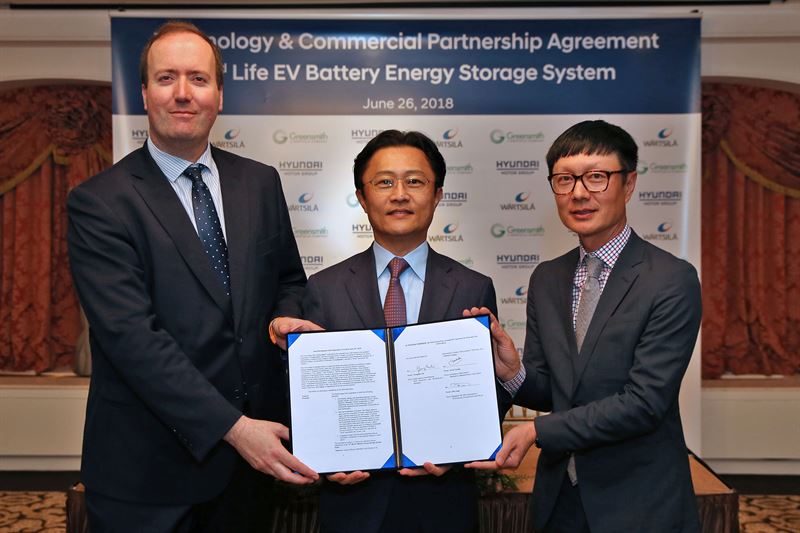Wärtsilä says it intends to use second-life EV batteries for utility-scale and commercial & industrial storage solutions, which it has been developing across the globe. To achieve this Hyundai and Wärtsilä are creating a supply chain with the goal of repurposing EV batteries.
The principal partner in this is Greensmith Energy Management Systems, which was acquired by Wärtsilä last year. The company provides grid storage solutions and energy management software to utilities and industrial costumers on a global scale.
John Jung, President & CEO of Greensmith told pv magazine that he expects shipment of batteries from Hyundai to commence with immediate effect. Furthermore, Jung says that orders have been filed, through Wärtsilä, adding to its existing generation capacity, and other customers in the industrial sectors.
Wärtsilä refers to a massive overcapacity of second-life EV batteries as a reason for capitalizing on this market. According to the announcement, in 2025, there will be 29 GWh of second-life EV batteries available. Today's storage market is around 10 GWh.
For the first couple of years, however, Jung tells pv magazine the market will not allow for the shipping of too many second-life EV batteries. The reason for this is that the EV market is neither big enough or mature enough, yet. In the future, however, the CEO is optimistic that the growing market, and the necessity to replace older batteries from models currently on the road, will serve to ramp up shipments significantly.
Jung explains that Greensmith is aspiring to produce on a multi-megawatt scale using second-life EV batteries. He also iterates that the company is already supplying storage systems on a multimegawatt scale to a global portfolio of customers, touting expertise in the market.
Seamless
Popular content
Asking about potential processes required to capitalize on EV batteries, Jung responded that the process primarily consists of rearranging the battery cells into packages used for utility-scale storage applications. There are, however, no additional chemical or other processes required to repower the batteries. The aim of the partnership, according to Jung, is to establish a seamless supply chain that can be replicated at scale to role multi-MW's of storage out in the future.
Jung goes on to say that the batteries would retain between 60-70% of their original capacity. Despite this degradation, the capacity of the batteries is still sufficient to run a profitable business for Greensmith, Wärtsilä and other industrial customers.
By giving EV batteries a second-life, both material and financial costs can be distributed across a longer life-cycle. Considering the extensive R&D costs of battery production and the entailing resource consumption, Hyundai and Wärtsilä say their repurposing is a logical step in attaining cheap storage. Not being able to disclose the exact saving, Jung stipulated that industrial customers will be able to achieve double digit savings per kWh by using second-life EV batteries.
Drastic reductions
In 2016, BNEF released a report stating that the use of second-life EV batteries can drastically reduce the costs of storage. Of the projected 29 GWh of end-of-life EV batteries in 2025, BNEF suggested around one-third (10 GWh) receive a second life as stationary storage. New storage systems can cost as much as US$1,000/kWh, but even by 2018, the cost of repurposing a used EV battery could be as little as $49/kWh. Add in the $400/kWh cost to convert to stationary, and the industry could be looking at masses of affordable batteries entering the market at a price point below $500/kWh.
Earlier this month, BNEF released an analysis showing that storage systems are going to play a vital role in the integration of renewable energy. Falling costs, thanks to EV manufacturing, are reportedly permitting the cheap and efficient utilization of renewable energy assets. The report also highlights the pivotal effect of the growing EV market on costs of energy storage and the entailing costs of renewable energy. The analysts at BNEF forecast a 50% renewable energy share in the global energy mix by 2050.
This content is protected by copyright and may not be reused. If you want to cooperate with us and would like to reuse some of our content, please contact: editors@pv-magazine.com.



By submitting this form you agree to pv magazine using your data for the purposes of publishing your comment.
Your personal data will only be disclosed or otherwise transmitted to third parties for the purposes of spam filtering or if this is necessary for technical maintenance of the website. Any other transfer to third parties will not take place unless this is justified on the basis of applicable data protection regulations or if pv magazine is legally obliged to do so.
You may revoke this consent at any time with effect for the future, in which case your personal data will be deleted immediately. Otherwise, your data will be deleted if pv magazine has processed your request or the purpose of data storage is fulfilled.
Further information on data privacy can be found in our Data Protection Policy.